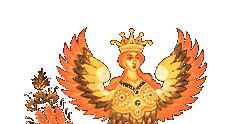Baba Yaga is a recurring figure in Russian folklore. Probably derived from the Hag, the third member of the three-part goddess (Virgin, Mother, and Hag), Baba Yaga is not good, but is not entirely evil; she does eat people and decorate her fence with their skulls, but she is known to help people that serve her. She also orders the cycles of nature. She is often called Baba Yaga "the Bony-legged." Her hut stands on chicken legs, and must be commanded to turn around so that one may enter. Baba Yaga flew through the air in a mortar, rowing with a pestle, and her house could run after its victims.
Linda Ivanits, in her book Russian Folk Belief, had the following to say on the topic of Baba Yaga and witches:
"There was probably no typical appearance for the witch of Russian folk belief, though occasionally the image of Baba Yaga, an ancient, bony, blue-nosed hag, seemed to cross over from the magic tale into preconceptions of what a witch should look like. S. V. Maksimov, for example, suggests that this was the usual image of the Northern Great Russian witch, whereas the Southern Ukrainian witches tended to be beautiful young widows. Such a division between northern and southern witches is too neat, and it is significant that the memorates and fabulates to which Maksimov later refers do not support it. They include young women as well as older ones among the Great Russian practitioners, and they often contain no mention of the witch's beauty or hideousness. Indeed, a survey of documents pertaining to witchcraft and of village traditions of "real" witches, as opposed to the descriptions of witches in the more fictionalized m magic tale, indicates that witches may be of any age. In those accounts where age is a factor, what seems to strike the popular imagination is not so much the resemblance to Baba Yaga as an unnatural longevity. The instance from the Kievan archives of the burning of the ancient woman suspected of unleashing a plague illustrates this point. Here, one must suppose, the popular attitude reflected the feeling that this woman should have died much earlier. The peasants sought an explanation for her failure to do so in the supernatural and saw in her an embodiment of sterility and enmity to the earth and, hence, the cause of the plague.
"Peasants attributed unusual and fantastic means of locomotion to witches. Sometimes they rode other people: numerous narratives relate how witches jump on unsuspecting victims who then become airborne and how, conversely, a clever person manages to bridle and ride the witch. Some reports tell of witches moving about like animals on all fours with loose, uncovered hair, wearing only a shift; other relate that they fly through the air using a broom, mortar, or poker as a vehicle or transformed into magpies. Peasant claimed that witches left home through the chimney and flew off to meetings or, more accurately, orgies with other witches and demons.
"Though Baba Yaga was primarily a personage of the magic tale, it appears that in a few places peasants believed such a witch actually lived deep in the swampy forest in a hut on chicken legs with her daughter Marinushka (Marina)."
|



